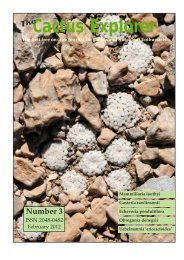Cactus Explorers Journal - The Cactus Explorers Club
Cactus Explorers Journal - The Cactus Explorers Club
Cactus Explorers Journal - The Cactus Explorers Club
You also want an ePaper? Increase the reach of your titles
YUMPU automatically turns print PDFs into web optimized ePapers that Google loves.
<strong>The</strong> <strong>Cactus</strong> Explorer ISSN 2048-0482 Number 4 May 2012<br />
Fig.8 A wonderful Echinocereus plant in bloom.<br />
mentioned, Weniger recognized var. gonacathus<br />
treating it as a valid taxon of plants with<br />
relatively small stature. He concludes after<br />
making observations of both White Sands<br />
plants and var. gonacanthus elsewhere that the<br />
the two are identical in every way except for<br />
size. To his credit, Weniger sought an<br />
explanation for this. He found his satisfaction<br />
in two examples of transplanted plants.<br />
Apparently he had friends in Albuquerque<br />
and Colorado who took 12 inch or taller plants<br />
from White Sands and planted them in their<br />
gardens. He claims that in both cases the stems<br />
shrunk to half their size within one year.<br />
Finally concluding that the population at<br />
White Sands is the most amazing example of<br />
the variation due to environment on any cactus<br />
species. In Flora of North America vol 4, page<br />
168, the idea in Weniger's five paragraphs are<br />
paraphrased (repeated) in a half paragraph.<br />
Namely that the size is strictly due to<br />
44<br />
environment.<br />
<strong>The</strong>re are a number of problems with<br />
Weniger's observations, however. First is his<br />
claim that the maximum size of these plants is<br />
a mere 18 inches. In my short visit to habitat, I<br />
easily found many plants over this and<br />
reaching up to 28 inches. However, Dave<br />
Ferguson reported to me that the largest<br />
example he found was a stem 6 inches in<br />
diameter and 6 feet in length. To imagine that a<br />
3 feet long stem is going to shrink and become<br />
a 6 or 8 inch specimen as var. gonacanthus has<br />
been defined, is quite a silly thought.<br />
Furthermore, a vigorously-growing large wild<br />
plant that is dug and moved to somebody's<br />
garden 100s of miles away is certainly going to<br />
suffer greatly from transplant shock. This is<br />
especially true within the the first year after<br />
transplant as Weniger cited. Last, but not least,<br />
the characteristics of seed-grown plants would<br />
be a far more proper test to determine the




